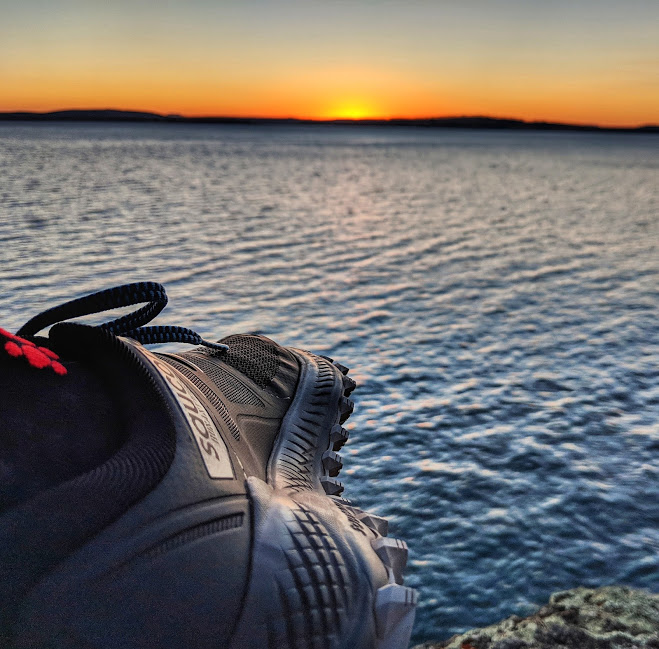Choosing running shoes can be a challenge. Especially when choosing from the vague shoe categories a most running stores, such as “motion controlled” or “neutral”. Below we discuss how comfort and shoe weight may be all you need to look for when purchasing your next pair of shoes.
Looking for trail running shoes? Check out our guide to “Trail Running” Shoes here.
History of Running Shoes and Running Injuries
Injury rates for runners have not changed over the past 40 years, despite significant changes on running shoe technology (Nigg et al.). This is surprising for most of us. However, it gives us an insight into our lack of knowledge on injury prevention. It also tells us that our lightweight cushioned running shoes may not be no better than the leather skins worn in the 1920s.

Traditionally, researchers have looked at impact forces (how hard you hit the ground) and the amount ankle rolling (pronation) when assessing the effect of shoes on injury rates. We see this in action when we head to the local running shoe store. Often the salesperson will require us to walk over a force plate which will assess where we place our weight and how much we pronate (ankle roll). However, recent research has found that these characteristics have little correlation with shoe type and injury rate (Nigg et al.).
So… how do we choose the best running shoes that will help reduce injury risk?
1. Comfort
It may seem simple to assess running shoes based solely on comfort. Surely there must be more to selecting the right shoes…right? A key research study by Muendermann et al. tells us otherwise.
In this study, soldiers chose the most comfortable insole from a choice of 6. The researchers found the soldiers equally preferred 5 out of the 6 insoles. They also found that after 6 months, soldiers that received their most comfortable insole had 53% less lower limb injuries, compared to a group of soldier that kept wearing their standard insoles. This study tells us that different individuals find different insoles comfortable. It also tells us that comfort is king!
Another study looked at the affects of comfort on oxygen consumption when running. They found that when participants chose their most comfortable shoe type, oxygen consumption/running economy when running decreased by 1% (Luo et al.). Although this doesn’t sound like a lot, it can make a big difference on race day!
2. Shoe Weight
When looking at running performance, running shoe weight can have significant impact. Studies have found that for every 100 grams you reduce your shoe weight by, performance increases by 1%. This is due to the energy costs of carrying extra weight when running. However, a recent review found that a combined shoe weight of about 440 grams is the maximum shoe weight before performance begins to decrease. If you wish to venture into the barefoot and ultra-minimalist styles of shoes, ensure you know what you’re doing (Barefoot running post soon to come).
We recommend reducing shoe weight slowly, as when shoe weight reduces often the level cushioning, stack height and shoe drop decrease. When you drastically alter any of these variables, risk of injury increases if the transition is too quick.
3. Foot Pronation
Pronation has long be the villain of the running world. We have been told by podiatrist, physio’s, doctors and shoe salespeople that the majority of us “over-pronate”. However, research is now showing that a moderate amount of pronation (ankle rolling) when running is associated with less injuries (Nigg et al.).

Given this information, it is important to choose a pair of running shoes based on how they feel and how comfortable they are, rather than sticking to a prescribed category of shoes even if they are uncomfortable.
Only when we excessively pronate our feet does injury risk increase. The vast majority of runners do not excessively pronate. If you are worried that your foot rolls in excessively when running, and you have a hip/knee/ankle injury, we suggest you see a sports podiatrist.
Summary
- Choose the shoes that are the most comfortable.
- Current shoe categories are out of date. Pronation is normal and it should not define which shoes you choose.
- Slowly reduce the weight of your shoes every time you buy a new pair. Remember, for every 100 grams lighter your shoes are equates to a 1% improvement in performance.
References
Fuller, J. T., Bellenger, C. R., Thewlis, D., Tsiros, M. D., & Buckley, J. D. (2015). The effect of footwear on running performance and running economy in distance runners. Sports medicine, 45(3), 411-422.
Luo, G., Stergiou, P., Worobets, J., Nigg, B., & Stefanyshyn, D. (2009). Improved footwear comfort reduces oxygen consumption during running. Footwear Science, 1(1), 25-29.
Nigg, B. M., Baltich, J., Hoerzer, S., & Enders, H. (2015). Running shoes and running injuries: mythbusting and a proposal for two new paradigms:‘preferred movement path’and ‘comfort filter’. Br J Sports Med, bjsports-2015.